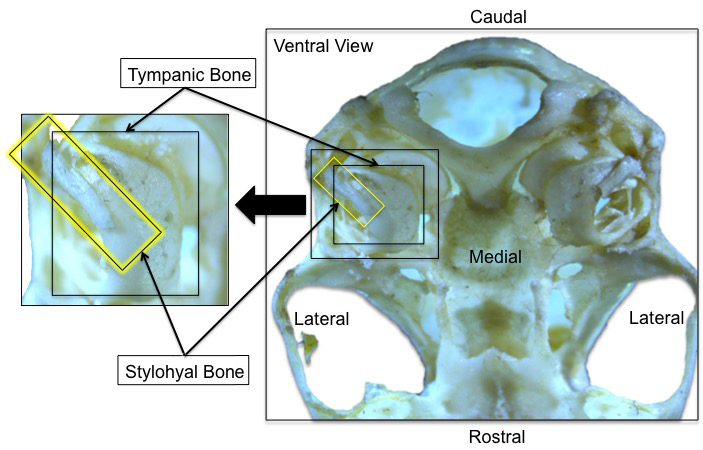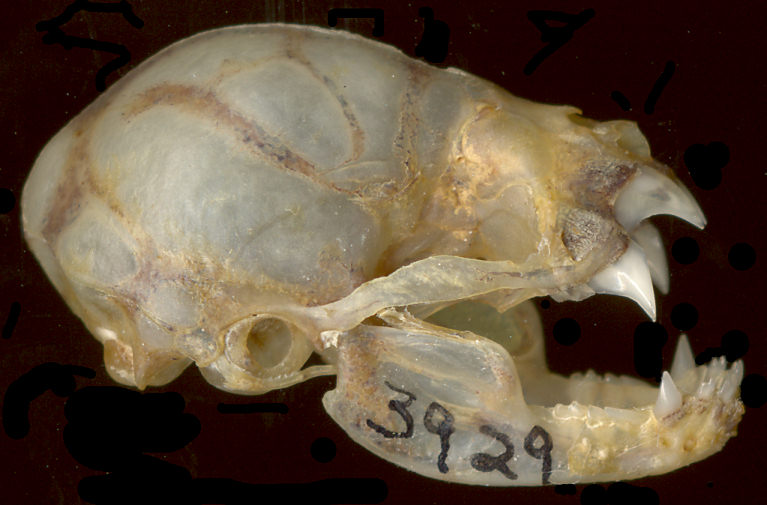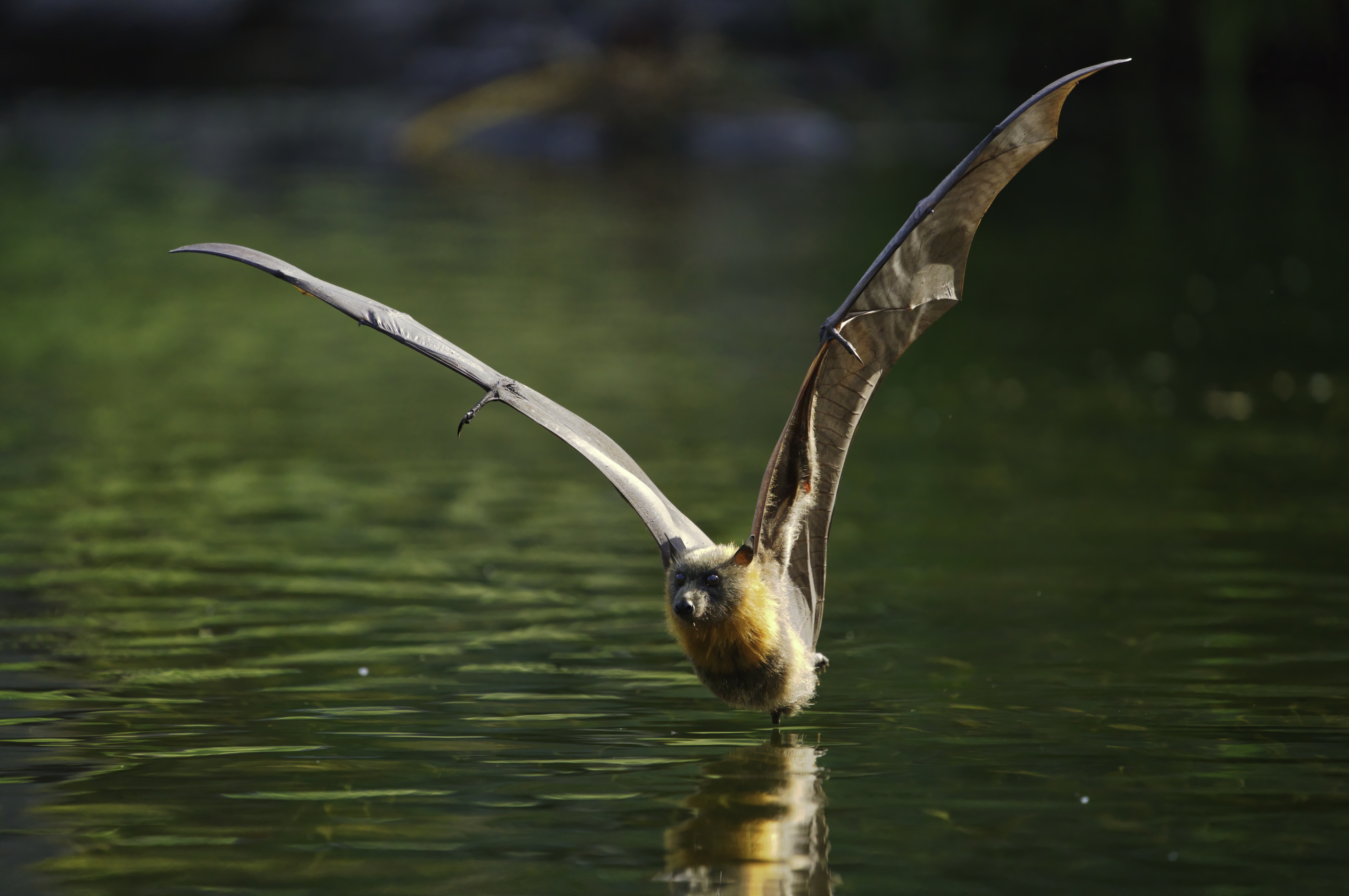|
Bat
Bats are flying mammals of the order Chiroptera (). With their forelimbs adapted as wings, they are the only mammals capable of true and sustained flight. Bats are more agile in flight than most birds, flying with their very long spread-out digits covered with a thin membrane or patagium. The smallest bat, and arguably the smallest extant mammal, is Kitti's hog-nosed bat, which is in length, across the wings and in mass. The largest bats are the flying foxes, with the giant golden-crowned flying fox (''Acerodon jubatus'') reaching a weight of and having a wingspan of . The second largest order of mammals after rodents, bats comprise about 20% of all classified mammal species worldwide, with over 1,400 species. These were traditionally divided into two suborders: the largely fruit-eating megabats, and the echolocating microbats. But more recent evidence has supported dividing the order into Yinpterochiroptera and Yangochiroptera, with megabats as members of the f ... [...More Info...] [...Related Items...] OR: [Wikipedia] [Google] [Baidu] |
Megabat
Megabats constitute the Family (biology), family Pteropodidae of the Order (biology), order Chiroptera. They are also called fruit bats, Old World fruit bats, or—especially the genus, genera ''Acerodon'' and ''Pteropus''—Pteropus, flying foxes. They are the only member of the Superfamily (taxonomy), superfamily Pteropodoidea, which is one of two superfamilies in the suborder Yinpterochiroptera. Internal divisions of Pteropodidae have varied since Subfamily, subfamilies were first proposed in 1917. From three subfamilies in the 1917 classification, six are now recognized, along with various Tribe (biology), tribes. As of 2018, 197 species of megabat had been described. The leading theory of the evolution of megabats has been determined primarily by genetic data, as the fossil record for this family is the most fragmented of all bats. They likely evolved in Australasia, with the common ancestor of all living pteropodids existing approximately 31 million years ago. Man ... [...More Info...] [...Related Items...] OR: [Wikipedia] [Google] [Baidu] |
Animal Echolocation
Echolocation, also called bio sonar, is a biological active sonar used by several animal groups, both in the air and underwater. Echolocating animals emit calls and listen to the Echo (phenomenon) , echoes of those calls that return from various objects near them. They use these echoes to locate and identify the objects. Echolocation is used for animal navigation , navigation, foraging, and predation, hunting prey. Echolocation calls can be Frequency modulation, frequency modulated (FM, varying in pitch during the call) or constant frequency (CF). FM offers precise range discrimination to localize the prey, at the cost of reduced operational range. CF allows both the prey's velocity and its movements to be detected by means of the Doppler effect. FM may be best for close, cluttered environments, while CF may be better in open environments or for hunting while perched. Echolocating animals include mammals, especially odontocetes (toothed whales) and some bat species, and, using s ... [...More Info...] [...Related Items...] OR: [Wikipedia] [Google] [Baidu] |
Vampire Bat
Vampire bats, members of the subfamily Desmodontinae, are Phyllostomidae, leaf-nosed bats currently found in Central and South America. Their food source is the blood of other animals, a dietary trait called hematophagy. Three extant bat species feed solely on blood: the common vampire bat (''Desmodus rotundus''), the hairy-legged vampire bat (''Diphylla ecaudata''), and the white-winged vampire bat (''Diaemus youngi''). Two extinct species of the genus ''Desmodus'' have been found in North America. Taxonomy Due to differences among the three species, each has been placed within a different genus, each consisting of one extant species. In the older literature, these three genera were placed within a Family (biology), family of their own, Desmodontidae, but Taxonomy (biology), taxonomists have now grouped them as a subfamily, Desmodontinae, in the New World leaf-nosed bat family, Phyllostomidae. The three known species of vampire bats all seem more similar to one another than to ... [...More Info...] [...Related Items...] OR: [Wikipedia] [Google] [Baidu] |
Microbat
Microbats constitute the suborder Microchiroptera within the order Chiroptera (bats). Bats have long been differentiated into Megachiroptera (megabats) and Microchiroptera, based on their size, the use of echolocation by the Microchiroptera and other features; molecular evidence suggests a somewhat different subdivision, as the microbats have been shown to be a paraphyletic group. Characteristics Microbats are long. Most microbats feed on insects, but some of the larger species hunt birds, lizards, frogs, smaller bats or even fish. Only three species of microbat feed on the blood of large mammals or birds ("vampire bats"); these bats live in South and Central America. Although most "Leaf-nose" microbats are fruit and nectar-eating, the name “leaf-nosed” isn't a designation meant to indicate the preferred diet among said variety. Three species follow the bloom of columnar cacti in northwest Mexico and the Southwest United States northward in the northern spring and then th ... [...More Info...] [...Related Items...] OR: [Wikipedia] [Google] [Baidu] |
Mexican Free-tailed Bat
The Mexican free-tailed bat or Brazilian free-tailed bat (''Tadarida brasiliensis'') is a medium-sized bat native to North, Central, and South America and the Caribbean, so named because its tail can be almost half its total length and is not attached to its uropatagium. It has been claimed to have the fastest horizontal speed of any animal, reaching top ground speeds over . It also flies the highest among bats, at altitudes around . It is regarded as one of the most abundant mammals in North America. Its proclivity towards roosting in huge numbers at relatively few locations makes it vulnerable to habitat destruction in spite of its abundance. For instance, up to 1.5 million bats reside under just one bridge in Austin. The Texas Legislature designated the Mexican free-tailed bat the state (flying) mammal in 1995. Taxonomy The Mexican free-tailed bat was described as a new species in 1824 by French zoologist Isidore Geoffroy Saint-Hilaire. Geoffroy placed it in the now-def ... [...More Info...] [...Related Items...] OR: [Wikipedia] [Google] [Baidu] |
Egyptian Fruit Bat
The Egyptian fruit bat or Egyptian rousette (''Rousettus aegyptiacus'') is a species of megabat that occurs in Africa, the Middle East, the Mediterranean and the Indian subcontinent. It is one of three ''Rousettus'' species with an African-Malagasy range, though the only species of its genus found on continental Africa. The common ancestor of the three species colonized the region in the late Pliocene or early Pleistocene. The species is traditionally divided into six subspecies. It is considered a medium-sized megabat, with adults weighing and possessing wingspans of approximately . Individuals are dark brown or grayish brown, with their undersides paler than their backs. The Egyptian fruit bat is a highly social species, usually living in colonies with thousands of other bats. It, along with other members of the genus ''Rousettus'', are some of the only fruit bats to use Animal echolocation, echolocation, though a more primitive version than used by bats in other families. It ... [...More Info...] [...Related Items...] OR: [Wikipedia] [Google] [Baidu] |
Common Vampire Bat
The common vampire bat (''Desmodus rotundus'') is a small, leaf-nosed bat native to the Americas. It is one of three extant species of vampire bats, the other two being the Hairy-legged vampire bat, hairy-legged and the white-winged vampire bats. The common vampire bat practices hematophagy, mainly feeding on the blood of livestock. The bat usually approaches its prey at night while they are sleeping. It then uses its razor-sharp teeth to cut open the skin of its hosts and lap up their blood with its long tongue. The species is highly Polygyny in animals, polygynous, and dominant adult males defend groups of females. It is one of the most social of bat species with a number of cooperative behaviors such as social grooming and food sharing. Because it feeds on livestock and is a carrier of rabies, the common vampire bat is considered a Pest (organism), pest. Its conservation status is categorized as least concern by the International Union for Conservation of Nature because of " ... [...More Info...] [...Related Items...] OR: [Wikipedia] [Google] [Baidu] |
Flying Foxes
''Pteropus'' (suborder Yinpterochiroptera) is a genus of megabats which are among the largest bats in the world. They are commonly known as fruit bats or flying foxes, among other colloquial names. They live in South Asia, Southeast Asia, Australia, East Africa, and some oceanic islands in the Indian and Pacific Oceans. There are at least 60 extant species in the genus. Flying foxes eat fruit and other plant matter, and occasionally consume insects as well. They locate resources with their keen sense of smell. Most, but not all, are nocturnal. They navigate with keen eyesight, as they cannot echolocate. They have long life spans and low reproductive outputs, with females of most species producing only one offspring per year. Their slow life history makes their populations vulnerable to threats such as overhunting, culling, and natural disasters. Six flying fox species have been made extinct in modern times by overhunting. Flying foxes are often persecuted for their real or pe ... [...More Info...] [...Related Items...] OR: [Wikipedia] [Google] [Baidu] |
Bat Flight
Bats are the only mammal capable of Active flight in animals, true flight. Bats use flight for capturing prey, breeding, avoiding predators, and long-distance migration. Bat wing Morphology (biology), morphology is often highly specialized to the needs of the species. Evolution Charles Darwin foresaw an issue with his theory of evolution by natural selection in the evolution of complex traits such as eyes or "the structure and habits of a bat."Darwin, C. (1968). On the origin of species by means of natural selection. 1859. London: Murray Google Scholar. Indeed, the oldest Onychonycteris, bat fossils are very similar in wing morphology to the bats of today, despite living and dying 52.5 million years ago.Sears, K. E., Behringer, R. R., Rasweiler, J. J., & Niswander, L. A. (2006). Development of bat flight: morphologic and molecular evolution of bat wing digits. Proceedings of the National Academy of Sciences, 103(17), 6581-6586. ''Onychonycteris, Onychonycteris finneyi,'' th ... [...More Info...] [...Related Items...] OR: [Wikipedia] [Google] [Baidu] |
Giant Golden-crowned Flying Fox
The giant golden-crowned flying fox (''Acerodon jubatus''), also known as the golden-capped fruit bat, is a species of megabat endemism, endemic to the Philippines. Since its description in 1831, three subspecies of the giant golden-crowned flying fox have been recognized, one of which is extinct. The extinct subspecies (''A. jubatus lucifer'') was formerly recognized as a full species, the Panay golden-crowned flying fox. Formerly, this species was placed in the genus ''Pteropus''; while it is no longer within the genus, it has many physical similarities to ''Pteropus'' megabats. It is one of the largest bat species in the world, weighing up to —only the Indian flying fox, Indian and great flying fox can weigh more. It has the longest documented forearm length of any bat species at . It is primarily frugivore, frugivorous, consuming several kinds of Ficus, fig and some leaves. It forages at night and sleeps during the day in tree roosts. These roosts can consist of thousan ... [...More Info...] [...Related Items...] OR: [Wikipedia] [Google] [Baidu] |
Greater Horseshoe Bat
The greater horseshoe bat (''Rhinolophus ferrumequinum'') is an Insectivore, insectivorous bat of the genus ''Rhinolophus''. Its distribution covers Europe, Northern Africa, Central Asia and Eastern Asia. It is the largest of the horseshoe bats in Europe and is thus easily distinguished from other species. The species is sedentary, typically travelling up to between the winter and summer roosts, with the longest recorded movement being . The frequencies used by this bat species for echolocation lie between 69–83 kHz, have most energy at 81 kHz and have an average duration of 37.4 ms. Description The greater horseshoe bat is the largest horseshoe bat in Europe.Schober, W., E. Grimmberger. 1997. It has a distinctive noseleaf, which has a pointed upper part and a horseshoe-shaped lower part. Its horseshoe noseleaf helps to focus the ultrasound it uses to 'see'. The greater horseshoe bat also has tooth and bone structures that are distinct from that of other rhi ... [...More Info...] [...Related Items...] OR: [Wikipedia] [Google] [Baidu] |
Kitti's Hog-nosed Bat
Kitti's hog-nosed bat (''Craseonycteris thonglongyai''), also known as the bumblebee bat, is a near-threatened species of bat and the only extant member of the family Craseonycteridae. It occurs in western Thailand and southeast Myanmar, where it occupies limestone caves along rivers. Kitti's hog-nosed bat is the smallest species of bat and arguably the world's Smallest organisms#Mammals, smallest mammal by body length (the Etruscan shrew is regarded as the smallest by body mass). It has a reddish-brown or grey coat, with a distinctive pig-like snout. Colonies range greatly in size, with an average of 100 individuals per cave. The bat feeds during short activity periods in the evening and dawn, foraging around nearby forest areas for insects. Females give birth annually to a single offspring. Although the bat's status in Myanmar is not well known, the Thai population is restricted to a single province and may be at risk of extinction. Its potential threats are primarily Anthropog ... [...More Info...] [...Related Items...] OR: [Wikipedia] [Google] [Baidu] |











